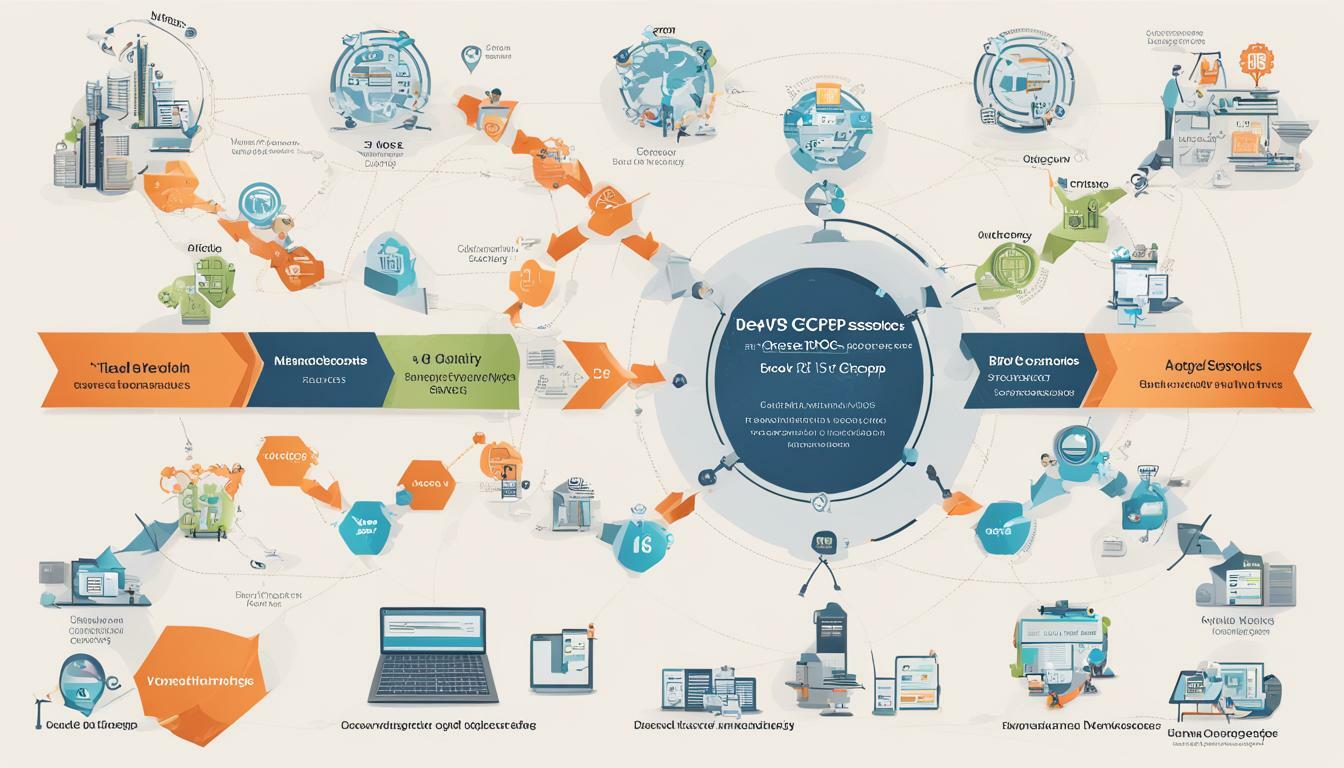
As businesses continue to embrace digital transformation and software development becomes an increasingly critical aspect of their operations, the need for secure and efficient software delivery has never been more crucial. This is where DevSecOps comes in.
Traditionally, DevOps practices have relied on the integration of development and operations teams to speed up the software development lifecycle. However, with the growing number of cyber-threats and data breaches, traditional DevOps practices are no longer enough to mitigate the risks and ensure secure software delivery.
In this article, we will explore the rise of DevSecOps and its growing importance in modern-day businesses. We will understand the evolution of DevSecOps, its benefits, necessary implementation steps, and the role of cybersecurity in DevOps. We will also highlight the tools and technologies available for successful DevSecOps implementation and discuss the challenges that organizations may encounter during this transition.
Key Takeaways
- Traditional DevOps practices are no longer sufficient for secure and efficient software delivery
- DevSecOps is becoming increasingly important in modern-day businesses
- DevSecOps involves incorporating security practices into the DevOps workflow
- Cybersecurity plays a crucial role in addressing the gaps left by traditional DevOps approaches
- Tools and technologies are available for successful DevSecOps implementation
Understanding the Evolution and Necessity of DevSecOps
DevSecOps is the natural evolution of the DevOps culture, which places equal importance on development, operations, and security. By incorporating security practices into the DevOps workflow, organizations can achieve a secure DevOps environment and streamline the software development lifecycle.
The benefits of embracing DevSecOps are manifold. It allows for better collaboration and communication between development, operations, and security teams, leading to faster and smoother delivery of applications. Additionally, it leads to improved security, as testing and security checks are integrated into the development process from the start.
Implementing DevSecOps requires a paradigm shift from traditional DevOps practices. Organizations need to adopt a proactive approach to security, and ensure that security is embedded throughout the development cycle. It involves breaking down the silos between development, operations, and security teams, and prioritizing security as a shared responsibility.
Secure DevOps practices are crucial in achieving a DevSecOps environment. This includes utilizing best practices such as automated testing, continuous monitoring, and regular vulnerability scanning. Organizations must also develop a security-first mindset and adopt a risk-based approach to security.
DevOps Best Practices in DevSecOps Implementation
When implementing DevSecOps, it is important to follow best practices. These include:
- Integrating security practices into the development process from the outset
- Automating security testing and vulnerability scans
- Implementing continuous monitoring to detect and respond to threats
- Prioritizing security as a shared responsibility
- Adopting a risk-based approach to security
By adopting these best practices, organizations can minimize security risks and vulnerabilities, improve the quality of their software, and achieve faster and more efficient delivery of applications.
The Role of Cybersecurity in DevOps: Addressing the Gaps
Cybersecurity is a critical component of any software development process, especially in DevOps. It helps address the gaps left by traditional DevOps practices and ensures that the software produced is secure and resilient. However, incorporating cybersecurity into DevOps can be challenging, and it requires a significant shift in mindset and approach. In this section, we will discuss the importance of cybersecurity in DevOps, the challenges faced, and the best practices to achieve a secure DevOps environment.
Importance of Cybersecurity in DevOps
With the increasing sophistication and frequency of cyber attacks, cybersecurity has become a top priority for organizations of all sizes. DevOps can help organizations deliver software faster and more efficiently, but it can also introduce a new set of security risks if not adequately addressed. By incorporating security into the DevOps workflow, organizations can ensure that their software is secure from the start and that any vulnerabilities are identified and addressed quickly.
Challenges Faced in Ensuring Security in DevOps
While the benefits of DevOps are well-known, incorporating security into the process can be challenging. Given the fast-paced nature of DevOps, security can often be seen as a hindrance to development speed. Additionally, the lack of communication and collaboration between security and development teams can lead to a siloed approach that ignores the security aspect.
Another challenge is the need to balance security with agility. In traditional software development, security was often seen as a separate phase that could be added on after development was completed. However, in DevOps, security must be integrated into every phase of the development process. This requires a new approach that balances security with agility, allowing organizations to deliver software quickly while ensuring it is secure.
Best Practices for Achieving a Secure DevOps Environment
To overcome the challenges of cybersecurity in DevOps, organizations must adopt best practices that integrate security into every phase of the development process. These best practices include:
- Collaboration and Communication: Security and development teams must work together and communicate regularly to ensure that security is integrated into the development process from the outset.
- Automation: Automation can help streamline the security process and ensure that security tools and practices are consistently and accurately applied throughout the development process.
- Continuous Testing: Continuous testing can help identify vulnerabilities early on in the development process, enabling them to be addressed before they become a significant security risk.
- Security as Code: Adopting a “security as code” approach helps ensure that security is integrated into the development process from the outset. This approach involves incorporating security practices and tools directly into the code, making security a part of the application rather than an afterthought.
By adopting these best practices, organizations can achieve a secure DevOps environment that enables them to deliver software quickly and efficiently while ensuring it is secure and resilient.
Tools and Technologies for Successful DevSecOps Implementation
Implementing DevSecOps requires the use of specialized tools and technologies that help streamline the process and ensure security is embedded into the development pipeline. There are numerous DevSecOps tools available that cater to different stages of the software development life cycle.
One of the primary goals of DevSecOps tools is to automate security practices so that developers can focus on writing code. Some of the popular DevSecOps tools include:
| Tool | Description |
|---|---|
| SonarQube | An open-source platform for continuous code quality that can detect technical debt, code smells, and vulnerabilities. |
| OWASP ZAP | An open-source web application vulnerability scanner that helps identify security vulnerabilities in web applications. |
| HashiCorp Vault | A secrets management tool that helps secure and manage sensitive information such as passwords, API keys, and certificates. |
While implementing DevSecOps can bring many benefits, it also presents various challenges. It requires a shift in mindset and cultural change that may not be easy to achieve. It also requires a robust security strategy and a clear understanding of the security implications of different tools and technologies.
Another challenge is choosing the right DevSecOps tools and integrating them into the existing development pipeline. The tools used should be compatible with the organization’s existing infrastructure and meet its unique security requirements.
Overcoming these challenges requires a multi-disciplinary approach that involves collaboration between different teams such as development, security, and operations. It also requires continuous monitoring and testing of the DevSecOps environment to ensure security is embedded at every stage of the development pipeline.
Conclusion
In conclusion, the rise of DevSecOps has revolutionized the traditional DevOps approach, bringing with it a new level of security and efficiency. The implementation of DevSecOps is crucial for businesses in today’ rapidly evolving landscape to remain secure and competitive.
By incorporating security practices into the DevOps workflow, businesses can mitigate risks and vulnerabilities that were previously left unaddressed. The benefits of adopting a secure DevOps approach far outweigh the challenges posed during the transition.
It is essential for businesses to prioritize cybersecurity in their software development lifecycle, and DevSecOps provides the framework for achieving this. With the right tools and technologies, organizations can seamlessly integrate DevSecOps into their workflows and ensure the security of their applications.
Overall, the adoption of DevSecOps is a necessary step for businesses to stay secure, competitive, and ahead of the curve in an increasingly digital world. Embracing this approach will not only benefit the business but also provide customers with confidence and trust in their applications. It is time to embrace the future of software development and incorporate DevSecOps into your workflows today.
FAQ
Q: What is DevSecOps?
A: DevSecOps is a software development approach that integrates security practices into the DevOps workflow. It emphasizes the importance of addressing security concerns throughout the entire development process, rather than treating it as an afterthought.
Q: Why is traditional DevOps no longer enough?
A: Traditional DevOps focuses primarily on speed and efficiency in software development and deployment. However, with the increasing number of cybersecurity threats and data breaches, security has become a critical concern. Traditional DevOps practices often neglect security measures, making them inadequate in today’s threat landscape.
Q: What are the benefits of implementing DevSecOps?
A: Implementing DevSecOps brings several benefits, including enhanced security measures, improved collaboration between development and security teams, early identification and mitigation of vulnerabilities, reduced risk of data breaches, and increased overall efficiency in software development processes.
Q: How do I implement DevSecOps?
A: Implementing DevSecOps requires a combination of cultural, procedural, and technological changes. It involves fostering a security-first mindset within the organization, integrating security practices into the development pipeline, automating security testing and scanning, and ensuring continuous monitoring and improvement of security measures.
Q: What are some best practices for achieving a secure DevOps environment?
A: Some best practices for achieving a secure DevOps environment include conducting regular security assessments and audits, implementing secure coding practices, integrating security tools into the development pipeline, providing security training to all team members, and establishing clear communication channels between development and security teams.
Q: Why is cybersecurity important in DevOps?
A: Cybersecurity is crucial in DevOps because it helps address the gaps left by traditional DevOps approaches. By integrating security practices, organizations can protect against potential vulnerabilities, reduce the risk of data breaches, ensure compliance with regulations, and build trust with customers.
Q: What are some challenges in ensuring security within the DevOps process?
A: Some challenges in ensuring security within the DevOps process include cultural resistance to change, lack of security expertise within development teams, difficulties in integrating security into existing workflows, and the need for continuous monitoring and updating of security measures.
Q: What tools and technologies are available for successful DevSecOps implementation?
A: There are various tools and technologies available for successful DevSecOps implementation, including vulnerability scanners, security testing frameworks, containerization platforms, secure code analysis tools, and continuous integration and deployment (CI/CD) pipelines.
Q: What challenges may organizations face during the transition to DevSecOps?
A: Some challenges organizations may face during the transition to DevSecOps include resistance to change, lack of awareness about the importance of security, difficulties in integrating security practices into existing workflows, and the need for upskilling and training team members on security best practices.






